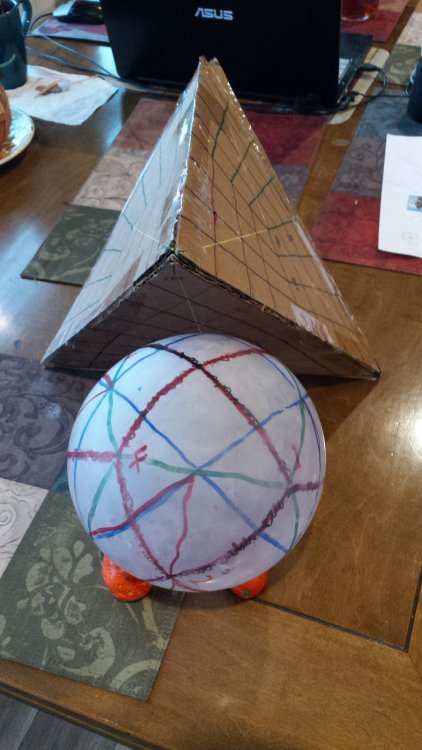-
Posts
4341 -
Joined
-
Last visited
Content Type
Profiles
Forums
Events
Everything posted by tar
-
Input screen deleting my responses. Talk to you all when I am free to express my ideas. Which given the bots and watchers around here is never.
-
I have read that many times over the years, and always have not agreed on what was proven or disproven We are back to the river question. Is the distance traveled by the photons along the river bottom, or through the ether. I submit that the mirrors at the end of the experiment were in different locations all during the experiment and at the beginning. The Earth is moving, the Sun is moving, the Galaxy is moving. Any one photon does not know it is in an experiment. Question for you. When a photon hits a mirror, is it the same photon that bounces off, or is the original photon absorbed and an identical quantum of energy released? So why not consider the Earth as a preferred frame? Then measure what is moving relative to it and what it is moving relative to? Relativity is, in my opinion understood completely when you notice that your location is unique and all other locations are a distance from you, and light takes time to travel that distance, And all other locations exist in a particular orientation to everything else, only once in the same way that your present happens only once.
-
I choose to consider that there is an absolute frame and that is the frame in which in which light travels. often in experiments there is a choice as to what you hold constant and compare everything against a photon does not know it is in an experiment. It just goes out from the source when an electron falls from one quantum level to another the fall creates a particle or a wave or some combination but an impulse that travels out across the fabric of space til it hits an electron in an atom somewhere and gives up its quantum of energy to the electron which then exists in a higher energy state you can't tell a lot from the energy that one photon hits with, you need a bunch to make a case a bunch can only be available if many sources are considered and they are created over time such is a problem when doing experiments or using data from distant stars where you get one photon an hour from the source and you don't know how the source changed in that hour but, I think there is experimental evidence that there is a reference frame that stays constant, because we measure the blue shift and red shift of hydrogen lines that tell us we are moving toward or away, relatively from the source
-
understood, but there is a difference considering the distance traveled relative to the river bottom and the distance traveled relative to the surface. there is disagreement as to what it is that light is crossing the ether is both proved and disproved in an experiment or an analogy you have to agree on what IS space are you crossing the river bottom or are you traveling across the surface
-
Here is a toothpick and clay version of the twelve sections of the sphere, made up of two tetrahedra. The yellow tetrahedra is one the red,green and blue is the opposite Note that the combination yields a cube and the center of each of the twelve diamonds is on the center of one of the edges of the cube.
-
I think I am not clear on what is standing for what in the river analogy. One of the confusions in my understanding of relativity is when distance is used in a spacelike way and when it is used in a time like way. My solution is to consider… My entry screen is confounded. Even in word.
-
the count or phase is similar to frequency in that each peak represents one count or tick if there is a certain amount of ticks per second that is the frequency my contention is that a light wave of a certain frequency does not change in reference to the universe that is it is doing what it is doing regardless of who or what notices it if you are moving in the same direction as the wave the ticks will be red shifted if you are moving toward the light the ticks will be blue shifted no time is warped no distance is warped
-
I have a question about how you sync moving clocks. for instance, if you sync a clock from here and the clock is 30 centimeters from here and you want it to read the same time when you get to it or it to you you have to send it the count on your clock and tell it to add a nanosecond to your count so that both clocks are reading the same proper time. if you sync all clocks at the start of the experiment to read the same proper time, according to their distance from a master clock, then moving toward another clock you would see a blue shift but the lag in time would be gone by the time you were in the same spot. Thank you Joigus for your time. I got it a few times but there is looking back and not getting it. I would explain, but a bot keeps preventing me.
-
Perhaps, perhaps not. You believe time is route dependent. I do not, the both bricks would fall in a parabola for the guy on the platform and straight down for the guy in the train I am unsure about the chapter where a boat is crossing a river at 5 miles and hour, pointed upstream so he gets to the shore across. Bondi says the effective speed is 4 miles an hour, but he confuses the amount of water traveled, with the distance to the other shore. This is crucial to not get confused because time flows like a river. You are carried downstream no matter what your angle of approach. That is, the water you first were on is downstream by the time you get anywhere. Consider a conveyor belt you would like to cross holding a marker touching the belt. The line you make would be a diagonal line of a particular length, longer than the distance across. In the various travels of Alfred and Charles, Hermann always resyncs clocks when the travelers are passing. I think if you properly sync the clocks at the start, there would be no need.
-
Here is a balloon I made for my Grandson. Not just any balloon but the whole of what I have been working on since the start of this thread. The green marker shows a cube. The blue marker shows a cuboctblahedron. The red marker with the brown squiggles on it shows a tetrahedron. The red marker with the black squiggles on it shows an opposite tetrahedron. Together the tetrahedrons make the twelve sections of the sphere. The red line connects the center of the numbered diamond sections.
-
Also, this discussion has pointed out the difference between a world map and a world picture. A picture is what the world looks like. A map is how the world is arranged outside your view. before I take a trip I like to look at where I am going on Google Earth I like to have a picture in my mind to compare against the picture I see while I am driving.
-
Thank you, I am rereading and reevaluating the arguments and math presented in Relativity and Common Sense, A New Approach to Einstein, written by Herman Bondi and published 1964. This, in an effort to answer your previous vector question. I am not saying that the equations of relativity give you wrong results, I am saying that the definitions and assumptions and the dropping and adding of dimensions can lead one to incorrect mathematical interpretations. In my imagination, I follow the travels of Alfred, Brian and Edgar, as they fly around syncing their watches upon meeting and sending out pulses every four seconds and following their pulses toward the next observer. I am never satisfied, in the descriptions, that the situation cannot be understood WITHOUT any time dilation or length contraction. In my interpretation, there is still private time and public time, or proper time, but HOW clocks are synced, and why is not done in what I consider a logical fashion. In my interpretation proper time is the universal time I talk about and private time is the local now I talk about. To me, the rest of the universe is experiencing only one thing at a time and that time is now. Things that happened before everywhere have already happened and will not happen again in exactly the same combination, because things change with time. Thing we see and experience in our local now are the effects of what happened before. We see the images and feel the vibrations of the things around us. Close things first, far things later, really far things never because we don't live long enough to see them arrive in our now. But the past has already happened and the past constructs our present and the present of every other location. Nothing happens in isolation. And the future has not happened yet, anywhere. So please give me a little time to finish Bondi and try to learn some of the transforms so I can transform the transforms into my space. I do not think the equations of relativity are wrong.
-
Studiot, Thankyou. I have not completely translated all or any for that manner equations derived from the original definitions of Minkowski space. I will endeavor to seek out a particular said equation with vectors and such and show that the relativity equations derived from original definitions would be equally obtainable using the dynamic model that I am using without deforming space or dilating time. Regards, TAR I am a big fan of geometric solutions. MigL, I have been trying to understand relativity, without requiring time dilation and length compression. I am not using the Minkowski diagram as the Minkowski diagram. I just noticed my thought has the future below and the past above, so it might be hard to true everything up in terms of equations, but I was trying to use a model or picture everyone has in their head as a basis for discussion. Since the Minkowski diagram is used to show how space deforms and time dilates and I don't require space or time to act in that fashion to comprehend relativity, I am thinking that things might work out mathematically with redefinitions of here and now and then and there and how you get between the two. Regards TAR
-
Rather than defining positions on the diagram as events, define the diagram as representing actual reality in the following manner and then locate the event in the resulting dynamic model. The hyperplane going through the origin is the present of all space, three dimensional space depicted in two dimensions, . This hyperplane falls through the dynamic model at 1 sec per second along the z axis. All past events for the observer at the origin existed above the plane but are visible as photons coming in from all directions, shown on the diagram as the upper light cone. The lower light cone represents photons or signals going out, at light speed from the observer. These light cones will intersect the falling hyperplane in increasingly large circles, representing the spherical shell of photons. Movement toward another location in space results in decreasing the time and/or distance between the locations. Both locations fall through time at 1 sec per sec and light travels always at C.
-
bufofrog, I don't understand why critical thinking is banned on this board. There is usually more than one way to explain a thing. I do not accept foreshortening, because it deforms reality. Pi for instance is not effected by velocity. However if your spaceship traveling at close to c traverses a circle, the circle becomes an ellipse with no cause and effect noted, or any concern for whether the circle becomes an ellipse for everybody, or just for the moving observer. If it happens just for the moving observer then the distant clock just appears to click differently, it does not actually tick differently. If you apply common sense to any observation, hold time as clicking off equally everywhere at once and factor in the light travel time between the two ends of the experiment, and the position of the observers and the position of the experimenter, you can resolve differences in observed time without requiring the universe to do magic tricks.
- 19 replies
-
-2
-
Not going to work Bufofrog. You wind up thinking the universe is weird, time dilates, distances shorten and there is dark energy and dark matter that we never needed before to explain mainstream physics. but fine, go ahead and muddle
-
Swansont, That is your loss to lock that thread topic. I cannot relay my understanding of relativity without using the two nows. You use them all the time. i am in no way saying the equations of relativity don't work. I am saying I understand relativity and I can explain the math without requiring space to deform or time to dilate. Regards, TAR
-
understood, but I am not calling anybody stupid. I agree the things happen the way people see them happen and report on them and figure them and such, but the assumptions vary. For instance you say the super nova is no longer happening. In one sense it is, because we are seeing it. In another sense it is not because it happened in that location in space a long time ago and something else is happening now in that location in space. But in order to understand this obvious fact about the universe you have to consider there are two nows and you told me that is not how it is...but that is how it is, so what is obvious? studiot I take your point about the term wavefront, but for this discussion the size of the wave matters too, in the sense that the size of a sine wave includes the measurement from peak to peak I think or valley to valley. But where does a wave start? At the zero point. When a photo is created by the drop of an electron from one energy level to another, this is a process or an event so to speak that in not instantaneous would argue, but happens over a short period of time. The wave edge starts as soon as the electron "starts" to fall and the whole fall creates a photon of said energy and frequency.
-
Understood did you e er work with fiber optic cable or was it copper I still don't think the logic is always sound. That is, one person might be making assumptions the other is not and vice a versa. What happens in the environment of the Earth, pretty much happens within the time it takes a light signal to get from one place to another. That is, we more or less can consider ourselves in the same moment. It takes time for a signal from our eye to get to our brain and such, so nothing is immediate. There is a fudge factor we commonly apply to consider something happening "at the same time", but for the sake of this discussion in terms of the size of an event, I think it worth while to consider the real difference between one side of an event and another. For instance, when someone says the event is happening now are they talking the leaf starting to fall, or the light striking the ccd recording the event? Cosmic events are even harder to agree upon the event size, because in a real sense, if you are just now seeing a super nova, it has both already happened, maybe 10 of thousands or millions of years ago, AND is actually still occurring because a photon from it, just hit your instrument. to relegate a super nova to a dimensionless point in a spacetime manifold would be sort of meaningless
-
Perhaps I am worrying over nothing, if this is already taken into account, but to have a T=0 you have to know if that is according to the event location, the experimenter's location, or the coincident detector's location. in the experiment it would be required to know the distances between all three and how their clocks were synced. for instance if a green leaf is falling the position of the leaf is different for someone a meter away and someone 2 meters away a milli second after the first guy sees it fall the guy standing a meter behind him sees it fall. When the second guy sees the first wave edge the first guy is seeing the hundred millionth wave edge, if the wavelength of green light is 500nm.
-
CollinJ was another poster in this forum that suggested he found a way to unify the big and the small. I did not want to hijack his thread nor associate myself with him as I thought such would prejudice those who are prejudiced against my thinking on this against his thinking on this. Where I see it matters in what we experience about the world and its behaviors, is that we "see" using photons. These little creatures are neither wave nor particle but have attributes of both. A particle is hard to pin down, as one cannot determine both the location and the momentum of a particle. You either know where it is or you know where it is going and where its been and how quickly it seems to be making the location change. Or the photon can be thought of as a wave which has an amplitude and a frequency. In both cases time and distance are required in order to describe the photon. Since we "see" using photons, the size and duration of the experiment is important to consider, because there is a light travel time to consider from one end of the experiment to the other.
-
CollinJ simple unification theory has an analogy to my problem with spacetime events and possibly has similar resolutions, but I did not want to associate myself with collinj as that would be a handicap for CollinJ. However we both have the same thought in terms of seeing something that goes against established theoretical math, and this morning I think I noticed the reason. In relativity a spacetime event is defined or represented as a point in a manifold and transforms are made between two observers of the point in two different inertial frames. The problem I have with this is an event is neither a point in space because it has a size, nor an instant in time, because it has a duration. By definition an event requires both a change in a situation over time and a volume of space in which to occur. So it would be an errored assumption to relegate an event to a dimensionless point. Perhaps resolving the size and duration of the "point" would square or "cube" the equation to match reality.
-
I was asked to explain what a stationary observer would measure concerning the clocks and distances of an orbiting observer. I would need, to properly predict, to know the distance of the third observer and the angle of view of the experiment. And I would have to be allowed to use the two nows. One universal now where everything only happens once. And one local now experienced by each of the separate observers. Additionally it would be useful to establish an external clock, like a pulsar and establish a starting count relative to that clock for each of the three observers. and i would have to know the distance and position of the pulsar relative to the experiment and experiment observer. Consider an observer right now on a planet orbiting alpha proxima or some star 3 to 5 light years from here, looking at the Earth with a really powerful telescope. If they would look at my dad’s house in NJ they might see him leaving the house or sitting outside. However in our local now my father has passed away. The many local nows are separated by distance which translates to time, as the Mars rover has already done, 24 minutes ago, anything we see it do now. But my contention is the Mars rover is only doing one thing at a time and it is doing something right now. The signals that recorded that event will reach us in 24 minutes, or however far away Mars is from Earth right now. Mars is actually 24 minutes advanced in its orbit from where we see it, but to grasp that you have to consider two nows.
-
doppler shift is well studied I mean the photons do not know who is receiving them. They move along at the speed of light no matter what. Consider the two nows idea and you will understand how something can look blue shifted without the frequency of the initial vibration of the source being slowed or quickened. Consider again the pulsar thought experiment. Using the idea of two nows, one local and the other universal, there are in actuality all the waves of light the pulsar is putting out, right now in space, that we will see for the 10 thousand years or however far away the pulsar is. If you move quickly toward the pulsar you will experience the pulsars beat as speeding up. It has not sped up. Your space craft has not shrunk. Space has not deformed. understood but I am not discounting observations I am understanding what is going on, and providing a way to understand actual reality without requiring it be wierd. a bot or watcher is confounding my entry screen. I have tried, but time dilation and length contraction do not work out in my thought experiments. What does the term incorrect science mean to you. That I don't see the world correctly or that I don't adhere to the assumptions and applications of accepted theory. I think the universe makes sense. Excepted theory requires the universe be wierd. Whose view is more sensible? I don't think you can get shut down in a science forum for being a skeptic. I am after looking at the experiments from a common sense point of view where everything adds back correctly. I tried to answer but was confounded by the entry screen again. Was a good answer, by the way, but was deleted. it requires the universal now to parse that experiment and requires a knowledge of how far away the third observer is from the experiment and at what angle he is viewing the situation
-
I got shut down with the two nows idea because SwansonT thought I was going against mainstream science. I am absolutely not going against the results of the experiments. GPS works. What I am suggesting is that you can arrive at thre same equations without distorting space and time. Most clocks these days, like the heated Cesium ones work on the basis of a certain frequency of light being given off by a certain drop of an electron in the Cesium atom to a lower energy level. This particular frequency is always 9,192,631,770Hz. Now suppose you are traveling fast toward this light. It will be blue shifted. The space the waves exist in will appear to be shortened. The space however is not shortened. The speed of light remains the same, the frequency increases. Time does not speed up or slow down. Space does not lengthen or contract.





